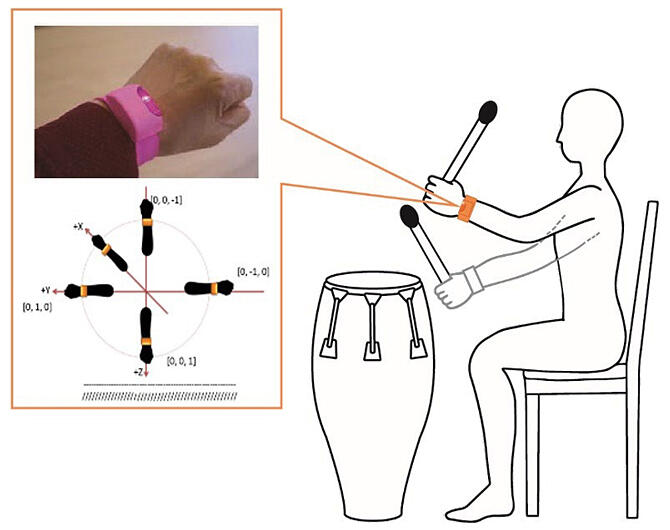A research group led by Project Researcher Atsuko Miyazaki at the Information Somatics Laboratory of the Research Center for Advanced Science and Technology and Project Professor Atsushi Hiyama of the Center for Advanced Science and Technology at the University of Tokyo and collaborators announced that they have developed a method to measure upper limb motor function relating to dementia by observing their arm movements during group drumming activities.
During a group drumming performance, wristwatch-type wearable sensors were attached to the dominant hand of 16 participants with dementia to accurately measure their movements. Arm elevation angle during drumming was identified to be related to the severity of dementia. These results are expected to contribute to early detection of cognitive decline and screening of patients with severe symptoms that are difficult to diagnose. The results were published in the international journal Frontiers in Rehabilitation Sciences.

Provided by the University of Tokyo
Current screening methods for dementia rely on neuropsychological tests; however, as the severity of dementia increases, patients find it difficult to understand the need for testing and often refuse to take them. Theses test scores may also be inaccurate for patients with visual or hearing impairments. A simple and safe way to monitor cognitive function is expected to help in the early detection of dementia and provide support that is tailored to individual symptoms.
Upper limb motor function decline has been associated with a decline in cognitive function and dementia. However, quantitative assessment of dementia-related specific motor dysfunction has been difficult.
In this study, the research group focused on rhythmic response movements and repetitive movements that can be performed even by individuals with severe dementia and examined the possibility of assessing upper limb motor function through drumming movements. Drummers can imitate the rhythms by listening to the beats played by others and thus can understand and reproduce the rhythm with minimal cues.
In addition, although shoulder flexion becomes increasingly difficult with the severity of dementia, patients can still raise their arm easily while drumming, allowing them to perform the movement repeatedly with the help of the mallets bouncing off the drum.
The study included 16 nursing home residents with a mean age of 86 years. Their degree of dementia was assessed using the Mini-Mental State Examination (MMSE), an internationally standardized neuropsychological test generally used for dementia screening. Participants' scores on the analysis ranged from 1 to 23 out of 30 (average 14.56), regardless of the degree of dementia.
Participants wore a wristwatch-type device equipped with an accelerometer and gyroscopic sensor on their dominant hand. They played the drums according to the facilitator's instructions for 30 minutes. Initially, the participants played drums at their own pace, but gradually, they were able to maintain synchronized drumbeats in response to the facilitators' instruction and entrainment phenomenon (a phenomenon of gradual mutual synchronization through communication).
Facilitators needed to acquire a specific skill to successfully lead the participants to reach the entrainment phenomenon, and they could gain this skill through training.
The average arm velocity and the average arm elevation angle were analyzed specifically for the 20-minute segment of the drumming program in which all participants played the drums. This analysis also revealed that participants with dementia were able to engage in drumming successfully.
Initially, the study established a correlation between arm movement during drumming and handgrip strength, which is a conventional assessment method for upper limb motor function.
Subsequently, the study also reaffirmed the correlation between handgrip strength and elevation angle during drumming, which indicated that arm elevation angle is a valid measure for assessing upper limb motor function. After examining whether drumming movements correlated with cognitive function, the study demonstrated a correlation between the average arm elevation angle during playing and general cognitive function. The model combining the average arm elevation angle and handgrip strength was able to explain cognitive dysfunction in older adults with dementia. Notably, the severity of dementia did not significantly correlate with the average arm velocity.
The research group has developed the Drum Communication Program for individuals with dementia and other patients, demonstrating its effectiveness in improving cognitive function, upper limb physical function, and shoulder elevation angle. Intervention programs or music therapy offer the possibility of functional assessment and these programs are expected to be available for clinical use in the near future.
Miyazaki commented, "In the future, we will measure not only the drumming movement but also the way of beating to verify whether the foci responsible for dementia can be identified. We are working to have the Dementia Severity Screening Test perfected through continued research. The COVID-19 pandemic delayed the implementation of the verification experiment, but we hope to conduct it this fiscal year."
Journal Information
Publication: Frontiers in Rehabilitation Sciences
Title: Association between upper limb movements during drumming and cognition in older adults with cognitive impairment and dementia at a nursing home: a pilot study
DOI: 10.3389/fresc.2023.1079781
This article has been translated by JST with permission from The Science News Ltd. (https://sci-news.co.jp/). Unauthorized reproduction of the article and photographs is prohibited.




